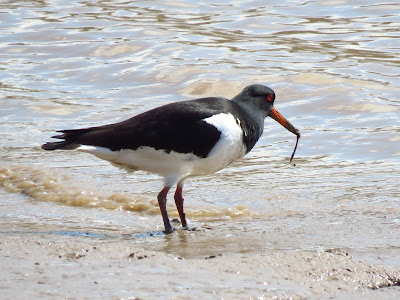Oystercatchers are instantly recognisable waders, with their pied plumage, black above, white below, and their straight orange bill and sturdy pink legs. Their eyes are dark red with a red ring around them. There is a lot of variation in bill shape and length, partly due to sex differences (females have a longer and pointier bill), but also individual preferences for prey. Individuals preferring worms have longer bills, whereas those favouring mussels have shorter, more chisel-like bills. Oystercatchers are long-lived birds, the record is 43 years old, by an individual ringed at the Wash. They are also quite site-faithful, breeding and wintering in the same areas year after year. Unlike other waders, they bring food to their young, so they are able to breed on flat roofs and do this regularly. The young are dependent on their parents for a longer time than other waders too. They are more limited to the coast in the winter, but they are increasingly breeding inland, where they have added gravel quarries (and roofs) to their nest sites. When inland (or during high tides) they regularly feed on earthworms from grasslands.
The Oystercatcher is a scarce and localised species in Hull. Oystercatcher records concentrate between the end of February and July, where most records are probably of birds on passage. There has been historical breeding of very few pairs: in the eastern docks and near Hessle, but breeding has not been confirmed recently. The best place to see them is near the Siemens factory, at Victoria Dock. Some years they used Victoria Park lawns to feed. I have a surprising record at Pickering Park early one morning, but Pickering Park is quite close to the Humber so maybe this individual had moved inland to feed at high tide. As Richard Broughton comments, there are inland Oystercatcher records in several points around Hull, and being nocturnal migrants, they can be heard calling over the city during migration.
Oystercatchers are Amber listed due to recent population declines in the UK, and listed as Near Threatened globally in the IUCN Red List. In the city, individuals have been seen limping due to fishing line around their legs, which could be something that the urban Oystercatchers might be more exposed to than in the wider countryside. Overall the causes of the declines are unclear, increased predation, or reduction on shellfish numbers (eg. cockle beds) could be to blame.





No comments:
Post a Comment